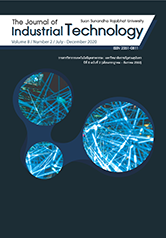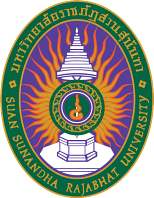Engineering Properties of AC 60/70 Asphalt Cement Mixed with Natural and Crumb Rubbers
คำสำคัญ:
Asphalt cement, Natural rubber, Crumb rubbers, Properties, Ternary mixingบทคัดย่อ
This research is to study the properties of AC 60/70 asphalt cement mixed with natural and/or crumb rubbers. The AC 60/70 asphalt cement was replaced by natural rubber at 5%, crumb rubbers at 11%, and mixed with natural rubber and crumb rubbers at 8%. The suitable scale of dry crumb rubber was sizing from 0.25 mm down and the testing of penetration, loss on heating, ductility, and stripping were measured. The result finds the higher viscosity homogenized of natural rubber led from ternary mixing material, better properties than binary mixing. The ternary mixing property values are more inclined toward single mixing natural rubber to 55.32 mm, 0.081 g, 29.62 cm, and 4.68 scores of penetration, loss on heating, ductility, and stripping tests, respectively. Ternary mixing natural and crumb rubbers should be subjected to more testing at other ratios to find out its suitable proportion for better properties of asphalt mixture.
เอกสารอ้างอิง
Department of civil engineering, Highway materials laboratory manual, Mahidol University Publisher, Nakhon Pathom, Thailand, 2012.
C. Terdkiat, “A study of asphalt concrete properties using asphalt cement with various proportion of natural rubber,” M.Eng. thesis (Construction and Infrastructure Management), Suranaree University of Technology, Nakhon Ratchasima, Thailand, 2016.
P. Ankana et al., “A study for properties of mixture of rapid setting asphalt emulsion (CRS-2) and concentrated latex”. In RSU National Research Conference (RSUSSH2019), Pathum Thani, Thailand, 2019, pp. 251-258.
W. Napharat et al., “The use of rubber mixed with asphalt,” Para. Rubber. Electron. Bull, vol.15, pp. 18-24, 2013.
Plastics Institute of Thailand, Driving of using rubber for building and repairing roads, The Office of Industrial Economics Publisher, Bangkok, Thailand, 2016.
L.G. Picado-Santos et al., “Crumb rubber asphalt mixtures: A literature review,” Constr. Build. Mater, vol.247, pp. 118577, 2020.
S. Kocak et al., “Fatigue performance assessment of recycled tire rubber modified asphalt mixtures using viscoelastic continuum damage analysis and AASHTO Ware pavement ME design,” Constr. Build. Mater, vol.248, pp. 118658, 2020.
S.A. Tahami et al., “The use of high content of fine crumb rubber in asphalt mixes using dry process,” Constr. Build. Mater, vol.222, pp. 643–653, 2019.
V.H. Nanjegowda et al., “Recyclability of rubber in asphalt roadway systems: A review of applied research and advancement in technology,” Resour. Conserv. Recycl, vol.155, pp. 105655, 2020.
Y. Sompote, “Old crumb and rubber can actually make the road,” Technol. Promot. Innomag Mag, vol.249, no. 13, pp. 19-20, 2016.
ดาวน์โหลด
เผยแพร่แล้ว
รูปแบบการอ้างอิง
ฉบับ
ประเภทบทความ
สัญญาอนุญาต
ลิขสิทธิ์ (c) 2021 คณะเทคโนโลยีอุตสาหกรรม มหาวิทยาลัยราชภัฎสวนสุนันทา

อนุญาตภายใต้เงื่อนไข Creative Commons Attribution-NonCommercial-NoDerivatives 4.0 International License.
บทความที่ได้รับการตีพิมพ์เป็นลิขสิทธิ์ของคณะวิศวกรรมศาสตร์และเทคโนโลยีอุตสาหกรรม มหาวิทยาลัยราชภัฎสวนสุนันทา
ข้อความที่ปรากฏในบทความแต่ละเรื่องในวารสารวิชาการเล่มนี้เป็นความคิดเห็นส่วนตัวของผู้เขียนแต่ละท่านไม่เกี่ยวข้องกับมหาวิทยาลัยราชภัฎสวนสุนันทา และคณาจารย์ท่านอื่นๆในมหาวิทยาลัยฯ แต่อย่างใด ความรับผิดชอบองค์ประกอบทั้งหมดของบทความแต่ละเรื่องเป็นของผู้เขียนแต่ละท่าน หากมีความผิดพลาดใดๆ ผู้เขียนแต่ละท่านจะรับผิดชอบบทความของตนเองแต่ผู้เดียว








